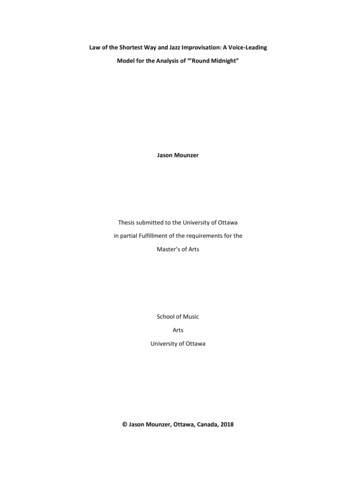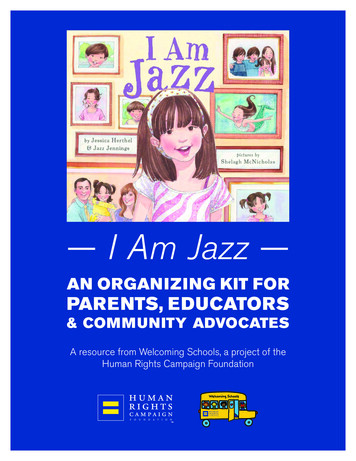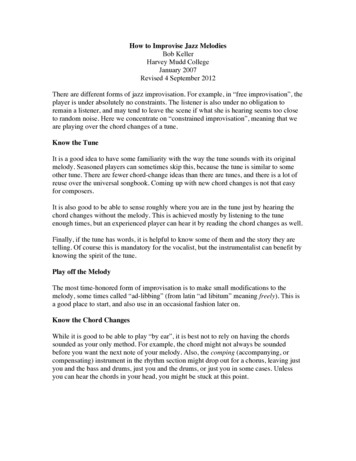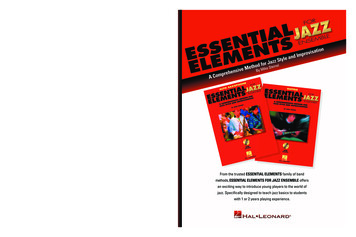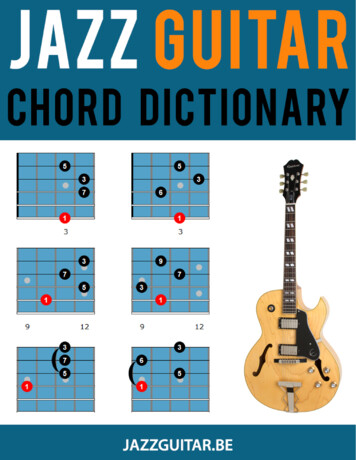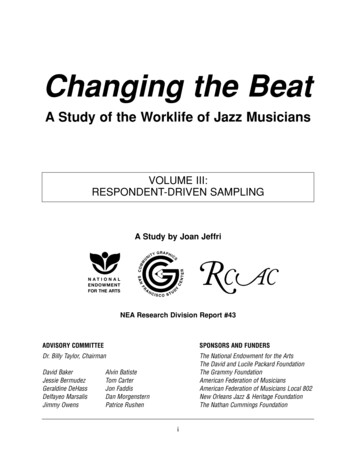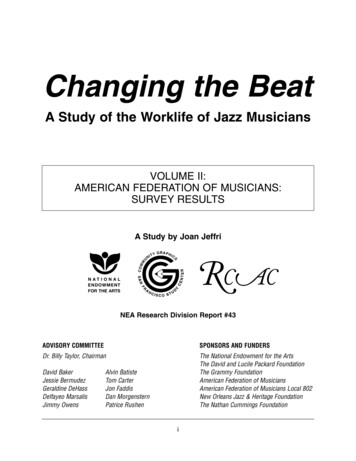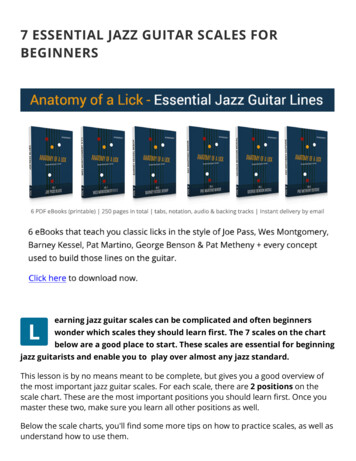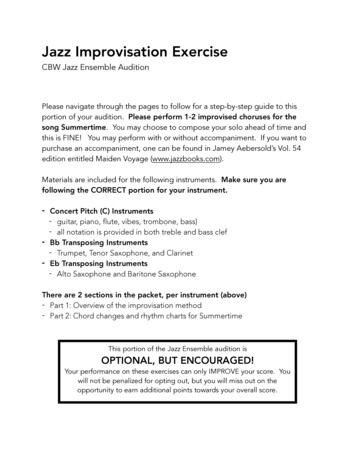
Transcription
Jazz Improvisation ExerciseCBW Jazz Ensemble AuditionPlease navigate through the pages to follow for a step-by-step guide to thisportion of your audition. Please perform 1-2 improvised choruses for thesong Summertime. You may choose to compose your solo ahead of time andthis is FINE! You may perform with or without accompaniment. If you want topurchase an accompaniment, one can be found in Jamey Aebersold’s Vol. 54edition entitled Maiden Voyage (www.jazzbooks.com).Materials are included for the following instruments. Make sure you arefollowing the CORRECT portion for your instrument.- Concert Pitch (C) Instruments- guitar, piano, flute, vibes, trombone, bass)- all notation is provided in both treble and bass clef- Bb Transposing Instruments- Trumpet, Tenor Saxophone, and Clarinet- Eb Transposing Instruments- Alto Saxophone and Baritone SaxophoneThere are 2 sections in the packet, per instrument (above)- Part 1: Overview of the improvisation method- Part 2: Chord changes and rhythm charts for SummertimeThis portion of the Jazz Ensemble audition isOPTIONAL, BUT ENCOURAGED!Your performance on these exercises can only IMPROVE your score. Youwill not be penalized for opting out, but you will miss out on theopportunity to earn additional points towards your overall score.
CBW Jazz Audition- ImprovisationConcert Pitch InstrumentsJazz ImprovisationAudition Overview for CONCERT PITCH INSTRUMENTS(trumpets, saxes, and clarinets scroll down for your document)Each candidate for Jazz Ensemble will perform a minimum of 1 chorus (16 bars) of improvisedsolo over the changes for Summertime by George Gershwin. If you are not somebody whousually volunteers to take solos in your current Jazz Band, PLEASE DON’T PANIC! We’regoing to walk you through an easy way to approach this.Improvisation MethodOn the main audition site (http://www.cbsd.org/page/17312), you will find a link to a fairly lengthlypacket that we use for the CBW Jazz Ensemble. This is a comprehensive step-by-step method.It’s HIGHLY recommended that you read through this method with your private teacher. Thereare exercises in there that can help you develop your skills as an improviser.Quick(er) walkthrough for this auditionIf anything appears confusing, refer to the big packet or schedule a time to work withMr. Delson prior to the due date.Chords in Summertime*Most chords in this piece are seventh chords, which means they contain 4 notes each. A fewhave 5 notes and are labeled below. Chords below are built from the bottom up, just as thoughyou were using notation. Numbers and solfeggi (do-re-mi, etc.) are used to label chord tones.Dm7Em7b5A7b9D7b9Gm7C7b9Fmaj77- C (te)1- D (do)6- Bb (le) 2-3- F (me) 1-2- E (re)5- A (sol)6- Bb (le)4- G (fa)7- C (te)1- D (do)6- Bb (le)7- C (te)3- F (me)4- G (fa)2- E (re)5- A (sol)6- Bb (le)4- G (fa)5- A (sol)1- D (do)2- E (re)7- C# (ti) 3-4- G (fa)2- E (re)3- F (me)5- A (sol)1- D (do)Eb (ra)F# (mi)Db (di)7- C (te)*The chords above are all in CONCERT PITCH. If you play a transposing instrument (trumpet, sax, or cln.), please see the appendix for your chords.Trombone, guitar, bass, piano, flute, and vibes version (Concert Pitch)1
CBW Jazz Audition- ImprovisationConcert Pitch InstrumentsPart 1: Voice Leading: Tonic to DominantVoice leading is the practice of moving one chord to another as smoothly as possible. Whenimprovising, good voice leading generally involves the last note we play under one chord TOthe first note we play in the one that follows.Tonic chords typically refer to the chord that reflects the key of the piece. Summertime is inconcert D minor, so for this piece, our tonic chord is Dm7. The Dominant chord typically refersto the chord built on the fifth consecutive note in that key, so for Summertime (D minor), theDominant chord is A7 (A is the 5th note in a D scale). We add a flat-9 to this chord to make itsound more interesting.Without going too much into WHY these movements work (refer to the big packet for that),here is the best way to move from Dominant to Tonic. The arrows show the best path for thebest choice for the last note to play over Dominant moving to the best choice for the firstnote played over Tonic. Any of these “pathways” work nicely. Experiment to see which youlike best.A7b9Dm76- Bb (le)7- C (te)4- G (fa)5- A (sol)2- E (re)3- F (me)7- C# (ti)1- D (do)5- A (sol)There are other choices, but these are the simplest to hear and understand. Notice that all ofthese movements are either half or whole steps.Trombone, guitar, bass, piano, flute, and vibes version (Concert Pitch)2
CBW Jazz Audition- ImprovisationConcert Pitch InstrumentsThis song contains several “secondary” dominants, so there are a few more chord to chordrelationships we want to look at:D7b9Gm7C7b9Fmaj7 2-3- F (me) 1-2- E (re)7- C (te)1- D (do)6- Bb (le)7- C (te)5- A (sol)6- Bb (le)4- G (fa)5- A (sol) 3-4- G (fa)2- E (re)3- F (me)Eb (ra)F# (mi)1- D (do)Db (di)7- C (te)This voice leading all works great, but the basic point is this:Find a tone in chord #1 that is a step (half or whole) away from a tone in chord #2. Makethose two notes the last, then first notes you play.When you aren’t worrying about voice leading, this piece GENERALLY stays in one key, whichmeans the SAME SCALE works for almost the entire song.D minor scale* : D-E-F-G-A-Bb-C-DEven if you don’t want to use any of the techniques discussed in thisdocument, you could play a pretty convincing solo by exclusivelyusing the notes above for the entire piece.Pretty convincing More advancedimprovisers may wantto use the Dorianmode. This requiresmore “changing,” but iship if you are cool withit. Check out the bigpacket for more info.On the next page, there are the FEW times you should make small adjustments. It will makeyour solo sound WAY better.See below for that info and a quick wrap up before we move to Part 2.Trombone, guitar, bass, piano, flute, and vibes version (Concert Pitch)3
Concert Pitch InstrumentsCBW Jazz Audition- ImprovisationSummertime- when to change notes (from the original D minor scale)A7b9: Replace C with C#D7b9: Replace F with F# (and Bb with B, but this isn’t as important)- the b9 here is Eb, which you can also change, but it’s not ESSENTIAL that you do thisAnd that’s pretty much it. Seriously.Part 1 Wrap Up- When moving from chord to chord, try your best to make the last note during the first chordlead nicely to the first note in the second. In some cases, the chords happen one per bar. Inothers, it’s two per bar.- The notes in the D minor scale will work for most of the tune. Your improvisation will soundmore convincing if you “make the changes,” for the chords listed above.Part 2: The Rhythm Chart MethodThe #1 challenge for young improvisers is keeping up with how fast everything is happeningwhen improvising. The chords are changing, the rhythm section is playing, and your brain can’twork fast enough to process it all with SIMULTANEOUSLY trying to play with convincing rhythmand harmony.It’s because we skipped a step. We tried to spontaneously improvise a solo before wethoughtfully composed a solo. So let’s try to do that now.Step 1: Pick a tune. We’ve chosen Summertime for this audition.Step 2: Have your teacher compose a convincing jazz rhythm. You’ll see that on the secondpage of your Summertime sheet with “beams with slash notation.”Step 3: Identify the “last and first” notes in places you want to voice lead.Step 4: Pre-determine which notes you want to use for your voice leading. Fill those in.Step 5: Fill in the remaining notes, making use of the proper scale tones and incorporating anyof the “note changes” from above.Step 6: Revel in how good you sound!See below for the process fleshed out. We’ll use the same chords as above, but differentrhythm that what you have on the audition sheet.Trombone, guitar, bass, piano, flute, and vibes version (Concert Pitch)4
C InstrumentsConcert Pitch Instrumentsover the changes to SummertimeC InstrumentsJazz ImprovisationCBW Jazz Audition- ImprovisationStep 1: Here’s your tune. We have isolated the first 4 bars (and beat 1 of bar 5) for this example.Jazz ImprovisationCBW Jazz Ens Audition 2016-2017Med Swingover the changes to SummertimeD‹7E‹7(b5) A7(b9)D‹7D7 & b c Med SwingG‹7CBW Jazz Ens Audition 2016-2017D‹7E‹7(b5) A7(b9)D‹7D7G‹7D‹7E‹7(b5) A7(b9)D‹7D7(b9)G‹7CStepInstrumentsc the chords,b2: Undera stylistically appropriate rhythm is provided for you.&Œ VV‰VVV VVŒ Ó& b V VJ V V ‰ VJ V V VJazzV V V ImprovisationVV VVVVÓJD‹7D‹7 C Instrumentsthe changes to SummertimeE‹7(b5)overA7(b9)D‹7D7(b9)E‹7(b5) A7(b9)D‹7D7(b9)G‹7G‹7& bb V VJ V V ‰ VJ V V V Vœ Vœ V V V# œ V œV V V Œ ‰ VJ V V V ‰ VJ V œV œV V Œ Óœ œ Jazz Improvisation CBW Jazz Ens Audition 2016-2017&Med Swingover the changes to SummertimeE‹7(b5) A7(b9)A7(b9) D‹7D‹7D7G‹7D‹7 D‹7E‹7(b5)D7(b9)G‹7Step 3:the œ“lastand first”notesinœD‹7places you wanttovoice lead. Theseœœ IdentifyD‹7E‹7(b5)A7(b9)D7(b9)G‹7 notes occurœ#œœ œœ oneœ # œto œanother.&bbbeforerightœ nœ&œ #œfrom œ œthe chordjchangesc‰œœ œ SwingC Instruments&bJMedD‹7 D‹7D‹7 œœœœÓœœEns œœAuditionjJazzŒ œ ‰CBWÓœœ Œ 2016-2017œ )D‹7D7(b9)E‹7(b5)A7(b9)D7(b9)œœœ D‹7G‹7G‹7G‹7œ œ œ toœ œSummertimechangesœ #œ cœ œ œ ‰‰ J œ œ overœ œ #thebœœb&b& V JVJ V V VJ V V V V V V V V V V V V ŒŒ ‰‰ JVJ V œV œV ‰‰ œJVJœV œV œV œV ŒŒ ÓÓ&D‹7 Med Swing E‹7(b5)D‹7D7(b9) CBW Jazz Ens AuditionG‹7 2016-2017D‹7E‹7(b5) A7(b9)A7(b9) D‹7D7(b9)G‹7œStep 4: Determinenotes you wantchord chart diagramsœE‹7(b5)œ toD‹7œuse for voiceœleading.# œ Use‰ the G‹7 V V V ‰whichbŒ‰Œ ÓœD‹7A7(b9)D7#œ&bVVVVVVVVVVVVVVVVVVVVV œVtoV which.œfrom above to make your selection. Follow the arrows to know which note leads& J cb & JJJD‹7D‹7bœ œ&bD‹7A7(b9) D‹7D‹7D7(b9)G‹7E‹7(b5)D7(b9)G‹7œ œE‹7(b5)œœ œ œ A7(b9)œœœœœ#œœœœœœœ#œœ##œœœ ‰ JE‹7(b5) œA7(b9)D‹7 œ Œ ‰ JD7(b9) œ œ ‰ œ œ œœG‹7œœœ Œ Ó&JJ& b V VJ V V ‰ VJ V V V V V V V V V V V V Œ ‰ VJ V V V ‰ VJ V V V V Œ ÓD‹7A7(b9)œ œ D‹7D7(b9)G‹7œE‹7(b5)œœœStep 5: Fillin theremainingnotes.Use (concert)Dœ minor œfor#everythingexcept the 2 changesœœœœ œœœœœœœ# œ in the D‹7b‰ JE‹7(b5)Œ ‰ JD7(b9)‰ œJ œ Tryœ œstayŒ melodic.ÓA7(b9)œ fourth.œG‹7to&D‹7listedabove.JNoticeœ thesecond bar and F#in theœ use ofœ #C#œœœ#œbBig,jumps and skips canœbe awkward. Consider using chord tonesœto œbegin each bar.& angularD‹7A7(b9)œ œ D‹7D7(b9)G‹7œE‹7(b5)œœœœœœœœ#œ œœœœœœœJ#œŒ ‰ J œ ‰ œJ œ œ œ œ Œ Ó&bJ ‰see next page for the above examples in bass clefTrombone, guitar, bass, piano, flute, and vibes version (Concert Pitch)5
CBW Jazz Audition- ImprovisationBass ClefInstrumentsConcertPitchInstrumentsBass Clef InstrumentsJazz ImprovisationJazzImprovisationoverthe changesto SummertimeBass Clef Examplesover the changes to SummertimeBass Clef InstrumentsBass Clef InstrumentsMed SwingBass Clef InstrumentsMed SwingStep 1D‹7 c D‹7?b ? b c CBW Jazz Ens Audition 2016-2017CBW Jazz Ens Audition 2016-2017E‹7(b5)JazzA7(b9) 9)D‹7D7over the changes to SummertimeG‹7G‹7Jazz Improvisationover the changes to Summertimeover the changes to SummertimeCBW Jazz Ens Audition 2016-2017Step 2Step 3Step 4D‹7 Med SwingE‹7(b5) A7(b9)D‹7D7(b9)G‹7CBW Jazz EnsAudition 2016-2017Med SwingD‹7E‹7(b5)A7(b9)D‹7D7(b9)G‹7? b D‹7 ‰Ens Audition‰CBWVJazzV G‹7V V VMedV SwingVJ V E‹7(b5)VE‹7(b5)V V VA7(b9)V V V D‹7VD‹7V V V ŒÓ ‰ ŒD7V V ŒŒ Ó2016-2017A7(b9)D7V V ‰VG‹7?J‰? bb V c JD‹7V V VJ V VE‹7(b5)V V V A7(b9)V V V VD‹7VVVVJ VD7 V V VJ V V G‹7VV Ó? b c VJD‹7 E‹7(b5) œA7(b9)D7(b9)G‹7?D‹7œ # œ D‹7œbD‹7 cœœG‹7œ E‹7(b5)E‹7(b5)A7(b9) D‹7D7(b9)œ? b D‹7A7(b9)D‹7D7(b9)G‹7œœ E‹7(b5)œ G‹7œœ D‹7A7(b9)?œœ #D7(b9)œœ? b D‹7 #œV V V VA7(b9)V V V V VD‹7V V V ŒŒ ‰‰ VJ D7(b9)V V V ‰‰ VJ V V VG‹7V ŒŒ ÓÓ? b VD‹7 VJ V V ‰‰ VJ E‹7(b5)bVVVVVVVVVVVVVVVVVVV V V VJ V VG‹7V VE‹7(b5) œ A7(b9)D‹7 œD7(b9)JJJ?D‹7 œ‰Œ‰œœb V œ œVJ V V œ VJE‹7(b5)œ V Vn œVœVV œV V A7(b9)V œV V#Vœ VD‹7VJD7(b9)V V V# œ‰ œVJ œV VœG‹7œV V Œ Óœœœ? b D‹7œD‹7 J j ‰ Jœ E‹7(b5) A7(b9)ŒD7(b9)œ œ œ D‹7œœ œŒ Óœœ œ‰ JœJ œ œœ G‹7œ œ œ ŒÓ ‰ œœD7(b9)D‹7G‹7?œ#œœœ œ œ œœ##œA7(b9)œœ œ œ œ ‰ œJœ E‹7(b5)‰? bb D‹7œ#œœA7(b9) œ D‹7œ Œ ÓœJœ? D‹7œœ#œE‹7(b5)D7(b9)G‹7œ #œ? bbœ œœ œœ œD‹7E‹7(b5) A7(b9)D‹7œD‹7E‹7(b5)A7(b9)jœœœœ? b œ œ jœ œ ‰ Jœ œ œ œ œ # œ œ œ œ D‹7œ œœ œ œ ŒE‹7(b5)A7(b9)D‹7? D‹7œœœ œœŒœ œ #œœ œ œ ‰JStep 5œ #œœ #œD7(b9) œ œG‹7œœœD7(b9)œœœ œ œ ‰ Jœ œ œ G‹7œ œŒ‰ œJœ #D7(b9)G‹7‰ # œ œ ‰ JœŒÓÓœœœb? b œ œj œ œ ‰ œJ œ œ œ œ # œ œ œ œ œ œ œ Œ ‰ Jœ # œ œ ‰ J œ œ Œ ÓJTrombone, guitar, bass, piano, flute, and vibes version (Concert Pitch)6
Concert Pitch InstrumentsCBW Jazz Audition- ImprovisationFinal ThoughtsThe concept behind the rhythm chart method is akin to using training wheels on your bicycle. Iwould recommend that you follow this path as you continue to develop as an improviser.1. Big Wheels: Use the teacher-provided rhythms to compose a solo.2. Training Wheels: Take away some of the rhythms and compose your own rhythms inthose “blank” bars. Check to see if they make rhythmic and musical sense.3. Parent Support: Student will compose solo with all of their own rhythms.4. Two-Wheeler: Use the rhythm (either your own or a teacher’s) to perform a solo, butDON’T compose ahead of time. Spontaneously improvise using the provided rhythm.*5. BMX: Student should spontaneously improvise over the tune without the written solo.* - Some musicians find #4 to be more difficult than #5 and find it constraining. If this is thecase with you, feel free to skip from #3 to #5.Should you “compose” your solo for Summertime for the audition?You absolutely should compose A solo for the audition to practice these concepts. Whether ornot you actually play THAT solo for the audition is up to you. I would love to hear what you cando spontaneously, but if you aren’t comfortable doing that yet, just play what you’ve written.Moving ForwardIf you found this stuff interesting and helpful, read through the big packet. It goes into muchmore detail. It would be helpful to
Jazz Improvisation Exercise CBW Jazz Ensemble Audition Please navigate through the pages to follow for a step-by-step guide to this portion of your audition. Please perform 1-2 improvised choruses for the song Summertime. You may choose to compose your solo ahead of time and this is FINE! You may perform with or without accompaniment. If you want to
